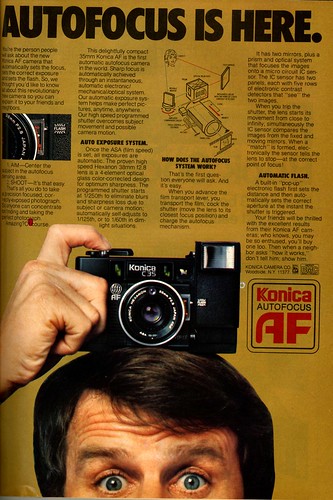Difference between revisions of "Autofocus"
Hanskerensky (talk | contribs) m (/photos/nesster/5538964661 changed rights from nc to cc after checking flickr image) |
m (added link) |
||
| Line 21: | Line 21: | ||
* ''Image splitting'' - the image is divided into two parts, and these are analysed by an autofocus sensor. This effectively creates a rangefinder - working by comparing light peaks and their phases in the two images. ''SIR'' - Secondary Image Registration is one example of this method. | * ''Image splitting'' - the image is divided into two parts, and these are analysed by an autofocus sensor. This effectively creates a rangefinder - working by comparing light peaks and their phases in the two images. ''SIR'' - Secondary Image Registration is one example of this method. | ||
* ''Contrast analysis'' - the contrast of the image is measured whilst adjusting the focus of the lens - the highest contrast is achieved when the image is in focus. This is more easily implemented in digital cameras, which already have a sensor and a processing system, and some video cameras. | * ''Contrast analysis'' - the contrast of the image is measured whilst adjusting the focus of the lens - the highest contrast is achieved when the image is in focus. This is more easily implemented in digital cameras, which already have a sensor and a processing system, and some video cameras. | ||
| + | |||
| + | == Links == | ||
| + | * Octavian Baltag. [http://article.sciencepublishinggroup.com/pdf/10.11648.j.si.20150301.11.pdf History of Automatic Focusing Reflected by Patents.] Science Innovation. Vol. 3, No. 1, 2015, pp. 1-17.doi: 10.11648/j.si.20150301.11 (pdf) | ||
[[Category: Focusing system]] | [[Category: Focusing system]] | ||
[[Category: Autofocus|*]] | [[Category: Autofocus|*]] | ||
Revision as of 20:07, 3 February 2016
Glossary Terms

|
| 1977 ad for Konica C35 AF, first production autofocus camera, using Honeywell Vistronic system scanned by Nesster (Image rights) |
Autofocus is a mechanism in an optical system which automatically changes the optics to focus an image. In a camera, this is used to focus the subject image, through the lens, onto the focal plane - the film or digital sensor.
Autofocus Methods
A number of different methods are used for autofocus:
Active Systems
Active Autofocus sends some form of energy towards the subject, then analyses the reflection:
- Sonar - ultrasonic sound is emitted by the camera; this is reflected from the subject back to the camera. The delay between the emitted and reflected sound is measured, giving a distance estimate, and the lens adjusted to this distance. Some Polaroid SX-70 cameras used this system.
- Infra-red beam - a pulsed infra-red light beam is emitted by the camera and reflected by the subject; the camera has an infra-red receiver set apart from the emitter. Adjusting the angles of emitter and receiver (in concert with moving the lens focus mechanism) and finding a maximum in the amount of light received gives a measure of the distance and a focused image. This method is common on compact film cameras.
Passive Systems
Passive Autofocus analyses the image arriving at the camera, without transmitting anything towards the subject - except in some cases an "assistance" light is used to illuminate the subject when it is too dark for there to be enough image for focusing.
- Image splitting - the image is divided into two parts, and these are analysed by an autofocus sensor. This effectively creates a rangefinder - working by comparing light peaks and their phases in the two images. SIR - Secondary Image Registration is one example of this method.
- Contrast analysis - the contrast of the image is measured whilst adjusting the focus of the lens - the highest contrast is achieved when the image is in focus. This is more easily implemented in digital cameras, which already have a sensor and a processing system, and some video cameras.
Links
- Octavian Baltag. History of Automatic Focusing Reflected by Patents. Science Innovation. Vol. 3, No. 1, 2015, pp. 1-17.doi: 10.11648/j.si.20150301.11 (pdf)